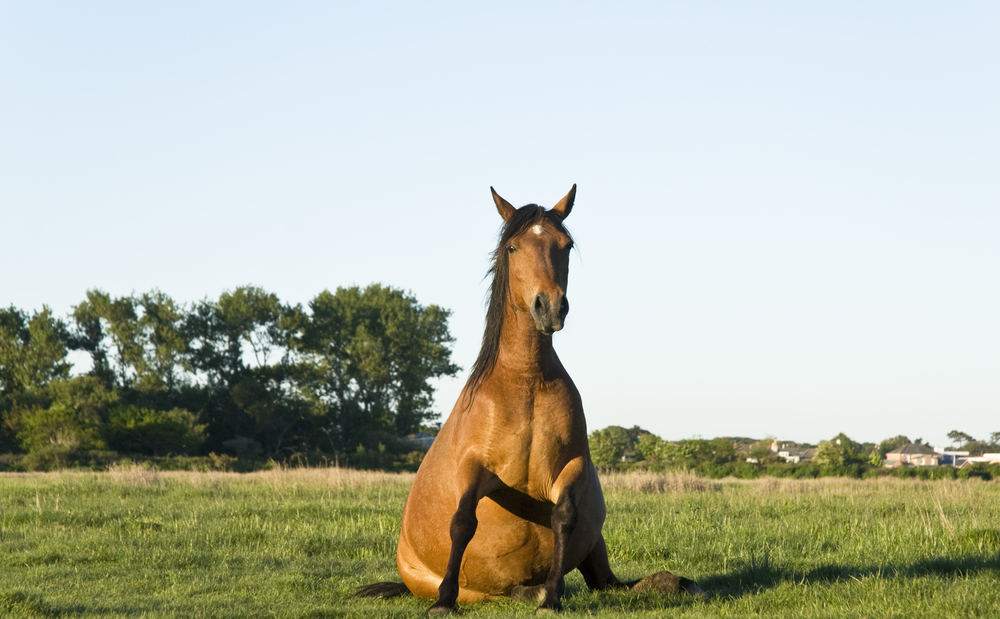- Your source for stall mats, rubber arena footing, arena harrows and arena dust control.

Without thinking about it, most people accept, as fact, that all animals can sit. After all, humans sit, dogs sit, lions sit, but what about a horse? Is it physically possible for a horse to sit, and if so, why don’t we see them sitting?
Horses cannot sit; however, they can approximate a seated position when they sit up after lying down. A horse will pass through a transient seated phase as they stand up. Sitting is uncomfortable for horses, and few horses will voluntarily remain seated for extended periods.
Most large four-legged prey animals are hyperaware of predator threats and thus avoid any position or activity that may cause vulnerability. While horses can lie down, they limit their time spent lying down due to the risk of a predator attack; is sitting the same? Can horses sit but refuse to do so for fear of predators attacking them.
Can Horses Sit Up Or Sit Down?
The seated position, regardless of species, is defined as having the torso erect and legs bent with the body weight supported by the buttocks, particularly the ischial tuberosities, i.e., the seat bones.
For a horse to achieve a true “sit” position, it would need to bend the hindlegs and shift its center of gravity backward. A horse cannot physically hold its torso vertically and thus cannot achieve an upright sit, like a two-legged mammal, i.e., human, monkey or chinchilla.
Rather a horse, like a dog or a cat, will need to approximate the erect torso position with its weight distributed across a tripod-shaped base of support. The tripod consists of the two front legs and the hindquarters.
The torso of a sitting horse is positioned diagonally relative to the ground, and the front legs will act as stabilizing “support beams.” The majority of the horse’s weight is supported by the structures surrounding its pelvis.
Due to the anatomical structures and biomechanics of a horse’s hind legs, they cannot lower their hindquarters into a sitting position. However, a recumbent horse will sit up as it transitions from lying down to standing.
How Do Horses Sit Up?
For a horse to sit up, they first have to lie down. Lying down is a relatively simple process for horses. They stretch their neck down to the floor, flex their front and hind legs, and let gravity do the work.
As the horse drops to a sternal position, they will twist their bodies to position their front and back legs slightly to the side and not directly under them.
It takes a great deal more coordination and strength for a horse to move from a lying down position to sitting and standing.
If the horse were lying flat on their side, they would roll back onto their breastbone (i.e., sternal position) with their legs tucked slightly to the side and under them. They then jerk their heads upwards, lifting the chest and freeing the forelegs to move.
Both forelegs are extended forward in front of the horse, and the horse digs its hooves into the floor.
As the horse pushes down on its forelegs, it raises its upper body while the hindquarters remain on the ground; this position is commonly called dog-sitting.
Dog-sitting is the closest approximation to sitting that horses can achieve.
The horse then rocks their weight forward onto the forelegs. As the weight is shifted forward, the hindlegs are positioned under the horse, and the hindleg joints are extended, raising the horse’s hindquarters to a standing position.
Most horses complete the transition from lying to standing so quickly that owners may not recognize the transient seated phase occurring prior to the horse standing.
Why Do Horses Sit?
There is no reason for a horse to hold a seated position for more than a few minutes. Unlike a dog or cat, who can use sitting as a posture of alert energy conservation, sitting in horses is exclusively linked to a positional transfer.
Positional transfers refer to the biomechanics required to move a being from one positional posture to another, e.g., a horse moving from lying down to standing upright uses a seated position as a biomechanical strategy.

Is It Harmful To A Horse To Sit For Long Periods?
There is little scientific evidence to determine how long is too long for a horse to remain in a seated position. Most horses will not stay seated; they will either find the strength and coordination to stand or collapse back down.
If a horse were to remain in a seated position for an extended period, theoretically, it could develop reperfusion, nerve, ligament, and muscle injuries.
Horses are massive creatures, and the unnatural distribution of weight in a seated horse could cause altered blood flow. Altered blood flow occurs when:
- Gravity causes the blood to pool in one or more locations.
- The horse’s weight stops blood from flowing to specific areas.
Impaired circulation and altered blood flow can cause temporary loss of function in oxygen-starved tissues. Ultimately prolonged oxygen deprivation will result in tissue death.
In addition to circulatory-linked injuries, extended pressure on nerves can cause damage to the nervous system. Nerve damage can result in hypoesthesia (i.e., loss of sensation), paraesthesia (i.e., altered sensation, e.g., pins-and-needles), and loss of motor function.
A horse who remains seated for an extended period will eventually collapse as its muscles stop working.
What Does It Mean If A Sitting Horse Can’t Get Up?
Most horses assume a classic dog-sitting posture due to:
- Pain, e.g., hindleg or abdominal pain
- An inability to stand up, e.g., paralysis, paraparesis, or generalized weakness
- Neck issues, e.g., arthritis that limits the neck movements.
Two of the most common reasons for the dog-sitting position in horses are colic and viral infection such as equine herpes virus.
While all colics could result in a horse dog-sitting, veterinarians have noticed an increased prevalence of dog-sitting in horses with sand impaction colics.
Neurological Equine Herpes Virus (EHV-1) can cause paralysis and ataxia in horses. EHV-1 causes an acute paralytic attack in rare cases, characterized by weakness and ataxia in the horse’s hind legs.
(EHV-1) can cause paralysis and ataxia in horses. EHV-1 causes an acute paralytic attack in rare cases, characterized by weakness and ataxia in the horse’s hind legs.
The horse does not have the strength or coordination to raise itself from a seated position. Most veterinarians will advise human euthanasia for a horse that can no longer stand.
Is Sitting Always Bad For Horses?
Sitting is a normal part of a horse’s movement pattern as they transition from a recumbent (lying down) position to standing.
Some horses will remain seated for a couple of minutes before completing the transition to standing. The extended “sit” phase does not necessarily mean that there is anything medically wrong with the horse.
It takes a lot of effort for horses to make that final “push” as they move from sitting to standing. If a horse is a bit lazy or tired, it may rest while it gathers the energy to put in the burst of effort required to stand.
Conclusion
Horses cannot achieve an erect sitting posture like a human and instead use an approximated posture known as dog-sitting.
Dog-sitting occurs when a horse moves from lying down to standing upright. A horse who cannot move out of a dog-sitting posture may be suffering from a disease or pain that has impaired its ability to stand.
References
- https://equusmagazine.com/horse-care/eqrolling3410-10373/

- https://aces.illinois.edu/news/horses-cant-lie-down-long

- https://horsesidevetguide.com/drv/Observation/426/dog-sitting-sitting-on-hindquarters-forequarters-raised/#:~:text=A%20dog%2Dsitting%20horse%20sits,an%20uncommon%20behavior%20in%20equines.&text=Occasionally%2C%20normal%20healthy%20horses%20do%20this%20too

- https://extension.usu.edu/animalhealth/ou-files/AG_Equine_2008-03pr.pdf

- https://www.afac.ab.ca/wp-content/uploads/2019/04/The-golden-hours-of-equine-rescue.pdf


